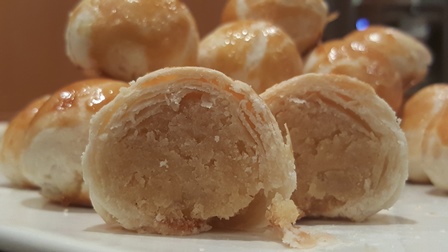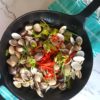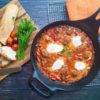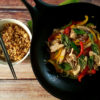My husband would risk a fine and stop the car along the road if he passes by a shop selling these just to get a box of freshly baked tau sar piah. If he travels to Penang or Malaysia, he will not forget to bring some home.
But the thing is… I am not the biggest fan, though I have baked it to sell since I was a teenager. This is such a well-kept secret, nobody knew until the last few days, when I was looking for my 30-year-old folder with my recipes and tricks. I lost it, and lost all the tips on how to make them perfectly.
So, I have to start all over, find a good recipe, experiment and get them right. This is the most difficult part of baking. You can’t get things right until you know the nitty-gritty details.
Here is a recipe that I have used to bake this batch. Of course, I have lost quite a bit of skills having not baked these for more than 20 years. But I can still make a thousand layer pastry decently, and they always taste wonderful fresh out of the oven.
A few tips to remember:
- The oil skin is made of low gluten flour, so it is not pliable.
- The water skin is made of high gluten flour, so it must be knead and always kept moist, so cling wraps and wet towels should be used to cover the dough waiting to be rolled when shaping one of them.
- The skin has to be folded at least 3 times to achieve many layers.
Bean-filled Chinese Biscuits (Tau Sar Piah)
Ingredients
Filing
- 300 g Dried Split Mung Bean soaked for minimum 4 hours until reconstituted
- or 500g of soya bean residue from making soya bean miilk
- 1 1/2 tsp Pepper
- 2 tsp salt
- 250 g Sugar
- 100 g Oil
- 2 Big Onions finely diced
Pastry
Oil Skin
- 125 g Low Gluten Flour cake or biscuit flour
- 35 g Vegetable Shortening or Pork Lard at room temperature
- 35 g Cooking Oil
- Pinch of salt
Water Skin
- 250 g Hi Gluten Flour bread flour
- 1 Tbsp Sugar
- Pinch of salt
- 65 g Vegetable Shortening or Pork Lard at room temperature
- 120 g Cold Water
Instructions
Filing
- Skip the first two steps if you are using residue from soya bean milk.
- Steam the soaked mung bean until soft, about 20 minutes.
- Mash it with a fork.
- Fry onions in the oil until soft and slightly browned.
- Add in the mung bean mashsoya bean residue/, add the sugar, salt and pepper.
- Cook until it has changed to a deeper colour and dryer, but still binds together when squeezed in your palm.
- Set aside.
Oil Skin
- Simply mix the oil, salt and flour. Set aside covered.
Water Skin
- Mix all ingredients and knead about 5 times, until the dough is slightly elastic. Set aside for 15 minutes.
Shaping the Biscuits
- Divide the filing, oil skin and water skin into equal portions. About 10g, 6g, 10g respectively.
- Wrap the oil skin within the water skin. Let rest for 5 minutes, covered with cling wrap.
- Roll out the skin into an oval as thin as possible. Then roll into a Swiss roll shape.
- Flatten the skin, and turn it 90 degrees. Repeat the previous step. Do this 2-3 times.
- Rest 5 minutes.
- Roll each dough skin into a flat circle and place the bean paste within each, seal.
- Brush pastry with egg yoke wash twice, ensuring the first egg wash is dried before applying the second layer.
- Bake in a 180°C oven for 20-25 minutes.
Here’s me showing you how to create the thousand layers and shape the pastry.
This teacher teaches it the best. All the tips are there, almost like how my own teacher taught me. My mum had asked a really good pastry teacher to teach me how to make these moon cakes, and the principles behind the crispy skin is the same.
Entrepreneurship Highlight
And here’s the history of Penang’s Tau Sar Piah. I love the kind of entrepreneurship. As a ex-lecturer of entrepreneurship in the university, I will always look out for such enterprising spirits. Love the way the younger generations revamp and revitalize the trade. No different from our Old Chang Kee, Polar, Jack’s Place, Yakun etc etc.
There are many old brands that served us well in Singapore which can benefit from the old skills and new entrepreneur knowledge. The popiah, bakzhang, galang guni, old hardware store, watch repair shop, pawnshop, porridge or chicken rice secret recipes. Who will be our next Singaporean Unicorn?





